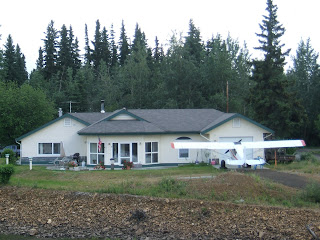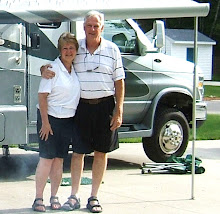



















 With our box of banana nut muffins in the jeep we stopped at the little expresso stand at the end of the road and then we're on our way to the Riverboat Discovery boat dock. Arriving about 7:30am we had breakfast sitting in the jeep. We used one of our Alaska Saver coupons which gave us one free ticket for the tour and saved us a goodly amount. We boarded the 4 story paddle wheeler Discovery III and found a great seat in front on the 2nd deck. While we waited to depart a couple joined us. Libby and Bill Hill from Louisville (yes it rymes). They were really sweet and she kept us laughing all morning.
With our box of banana nut muffins in the jeep we stopped at the little expresso stand at the end of the road and then we're on our way to the Riverboat Discovery boat dock. Arriving about 7:30am we had breakfast sitting in the jeep. We used one of our Alaska Saver coupons which gave us one free ticket for the tour and saved us a goodly amount. We boarded the 4 story paddle wheeler Discovery III and found a great seat in front on the 2nd deck. While we waited to depart a couple joined us. Libby and Bill Hill from Louisville (yes it rymes). They were really sweet and she kept us laughing all morning.The boat left and headed up the Chena River for our 3 1/2 hour sail. Lots of different types of homes from current log homes, Athabascan stone houses, fishing camps and a Bed & Breakfast built like an old gold dredge. Our first stop was along the shoreline to see a legendary bush pilot in action. Unfortunately it’s pretty cloudy and showery this morning so the pilot took off and displayed a short field take-off and water landing on the river. Bush pilots and planes played a vital role in the pioneering of Alaska, succeeding the riverboats in Alaskan transportation history. Because of Alaska's vast remote areas, service by airplane was (and remains) essential to the timely delivery of supplies.
Moving up the river again we arrived at the home and kennels of the late Iditarod Champion Susan Butcher and her husband Dave Monson. Dave now runs the kennel. From the deck we could see fluffy puppies and watched a team of dogs pull a 4 wheeler (no engine). It was very neat. We learned that sled dogs are not all Huskies. Many are a mix of breeds that will combine speed and strength to make a good sled dog. Susan entered the Iditarod 18 times and the men laughed…at first.. Susan won the race 4 times. Unfortunately she passed at age 51 of cancer.
The paddle wheeler powered us down the river where we witnessed the “wedding of the rivers”. The clear blue Chena River flows into the worlds greatest glacial-fed Tanana River. Glacial rivers have a gray-green silty color and when the two rivers meet there is a definite demarcation. The boiling current of the Tanana creates clouds of silt that rise and fall as they meet the clear Chena waters. Here our captain turned the boat and headed back up river.
We soon docked at the Old Chena Indian Village. This is an authentic Native Fish Camp and we got to experience their native traditions with friendly native guides who gladly shared their Athabascan/Eskimo cultures. We toured the village and learned a lot. Walking through the village with our guide there were cabins made of spruce logs, an authentic birch bark canoe made without any metal fasteners and a working fish wheel where they caught salmon. The women would fillet the fish in the traditional manner and hang the fillets in the smoke houses to dry for the next winter. Our guide explained how the ‘cache’ houses stored fur pelts, meat and other supplies high above the ground so animals would not get to the food. Also outside the ‘cache’ house hung samples of beautiful pelts used to make coats and clothing. We learned how the wolf, fox, martin, and beaver were used to provide food and protection in the harsh Arctic climate. One of our guides modeled an Athabascan Yukon-style women's winter parka with sunshine ruff. This was gorgeous and fully hand made!
With some time to wander through the village we came upon the "Iron Dog". The "Iron Dog" ,named by villagers when the 1st snowmobile came to Alaska, transformed village life in the 1960's when it began to replace dog teams as the main mode of winter travel. In the late 1950's Polaris released the original Sno-Traveler. The "Iron Dog" here in the village is restored to it's original condition. It has 16 hp and weighs 720 pounds.
The guides could relate stories from their grandparents who still live much as they did in the early days. Families go to ‘fish camp’ in the summer and are allowed to hunt for subsistence for their food through out the winter. They are working very hard to keep their culture alive. The young people go off to college and then return to work with their villages and find jobs locally. They continue to participate in the village preparations in the summer fish camps and to teach their ways to the young children.
Finally it was time to sail back up the river. On the way we passed the original Discovery paddle wheeler. The late Captain Jim and his wife Mary Binkley began hosting visitors to Alaska on tours in 1950 aboard the Discovery, a boat Captain Jim built in his backyard. As the years went on and Alaska’s beauty became more well known around the world, the Discovery II and Discovery III boats were built to accommodate the number of visitors interested in learning the history of the interior; its rivers, its people and its history. Mary was at Steamboat Landing waving and greeting us as we arrived back at the dock. The family still runs the business today and captains the boat. We were afraid the tour was going to be another touristy thing but it wasn’t! It was great and definitely something you should do when visiting Fairbanks.
Back at camp we relaxed and then went into town for an Italian dinner at Gambradellos. Cute little place on 2nd Avenue and good Eggplant Parmesan.
Later we watched TV and went to bed early. We have to be up at 3:30am for our next adventure!
It was a great day and we made two new friends.
Pictures: Discovery III Paddle Wheeler, Bush Pilot Landing on Chena River, Original Discovery Paddle Wheeler, Susan Butcher kennel, Sled Dog Puppies, Athabascan Fish Camp, Fish Camp Smoke House, Fish Wheel, Chena Village Post Office, Baby Caribou, Chena Village Bear Pelts, Yukon Style Coat (2), Cache and Pelts, Spruce Cabin, Ken relaxing in Chena Village, Ken driving Iron Dog, Iron Dog snowmobile, Camp on Chena River, Just Park in the driveway, Steamboat Landing

No comments:
Post a Comment